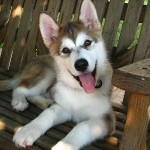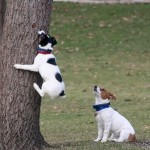Written by Senior Editor Peter Gehr
So you want to know the best puppy obedience training tips for all dog breeds? The very first steps should be taken immediately. In other words, your dog is ready for training from day one. One of the smartest dogs I ever owned learned to sit, stay, heel and fetch the day after he was weaned by his mother. It was astounding, but he was so obedient, and wanted to please so badly, that he was a natural and took on anything I wanted to teach him.
Make sure everyone around the dog understands the rules, and the program you adopt for training. A puppy can be untrained as quick as he can be trained if double-standard are brought into the equation. Furthermore, this will confuse and create insecurity for your new puppy.
Best Puppy Obedience Training Tips for All Dog Breeds
The following article expounds on this expansive topic:
Puppy obedience training should start as soon as you get the puppy. Your puppy should be educated so that you can enjoy a good long-term relationship. Obedience training can start as soon as the puppy reaches 4 to 6 weeks of age. Learning the rules of the house takes a lot of work and patience. The puppy training is much more efficient if you set a schedule for you and your puppy.
Puppy Obedience Training Schedule
Before you start training your puppy you should make a plan considering the best training method for you and your dog.
The plan involves setting some goals, establishing what behaviors you want to eliminate, the means of reinforcing positive behavior you will use and the training schedule.
You should start with short sessions which should repeat several times a day. For instance, you can establish the length of your training session to be of 10 to 15 minutes and repeat it 2 or 3 times a day. The puppy’s attention span won’t allow longer sessions. Even in some mature dogs it is difficult to make them stay focused longer.
You should not interrupt your puppy when he is performing an activity he likes because you might not get his attention. Try to schedule training sessions at regular intervals so that your puppy gets accustomed to the schedule. Dogs get used to habits easily, so it should not be too difficult to get your puppy accustomed with the training sessions.
Repetition is the key in puppy training. Repeat the same exercise until your puppy does it correctly. Stop when you get the result you wanted. This way, your puppy will see a reward in successfully accomplishing the task.
Planning the Lessons
When scheduling your puppy training, plan the lessons you intend to teach him. You should start with basic commands and teach the same command for several sessions if needed. It is important that your puppy learns the command. The easiest to learn is ‘sit’. Then you can move on to ‘stay’, ‘lie down’ and ‘come’.
Teach one command at a time. It is easier for your puppy to learn if you focus on a specific action. However, you can make a command more complex. For instance, when teaching ‘stay’, you can move away from your puppy and teach him that he should stay even if you are away from him.
Make sure you start the training session when you have your puppy’s full attention. If he is playing with his favorite toy or with another animal, your ‘come’ command will sooner be interpreted as ‘ignore’ and he is most likely to ignore it.
It is important that your puppy obeys the basic commands before he learns more complex tricks. Click here to visit the original source of this post
With the best puppy obedience training tips for all dog breeds in place in your household, you will be amazed at what can be accomplished if you spend the time with your new dog. These early development days are critical to his/her education and establishment within your “pack”. The dog will be rapidly growing physically and education is paramount to a successfully trained and happy puppy. To neglect this part of your pet’s life will cause problems that will develop quickly and you may soon have a monster on your hands if you don’t train. It’s your responsibility to take the place of your puppy’s mother, who taught your pup lessons from the day it was born. Cesar Millan is a great advocate of thinking as a dog thinks, and treating your dog as a dog and not as a human. I totally agree with this approach to help your dog learn to the best of his ability.




